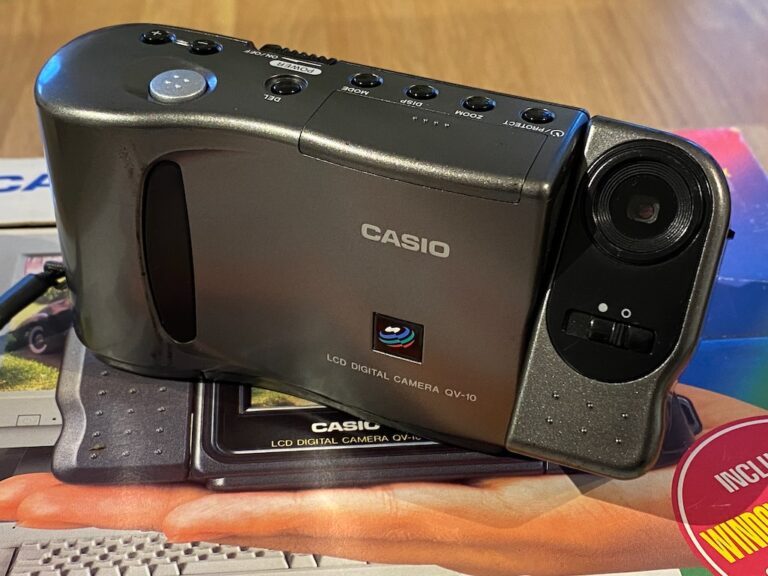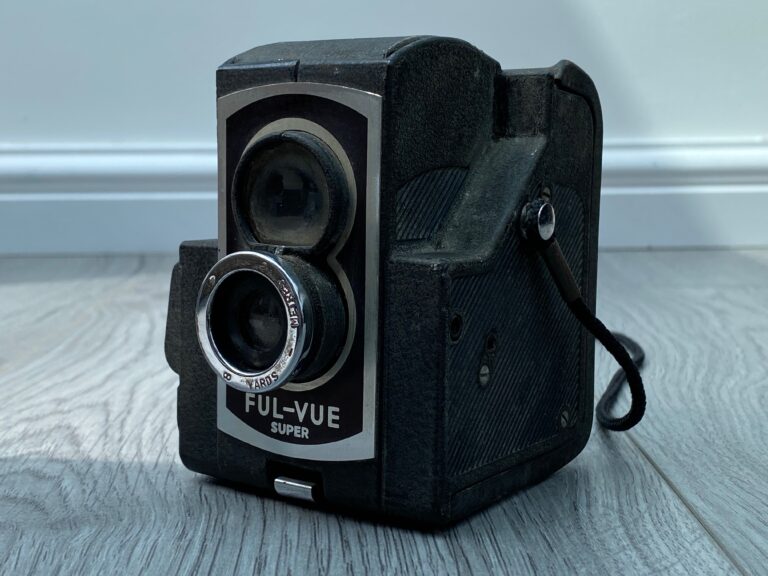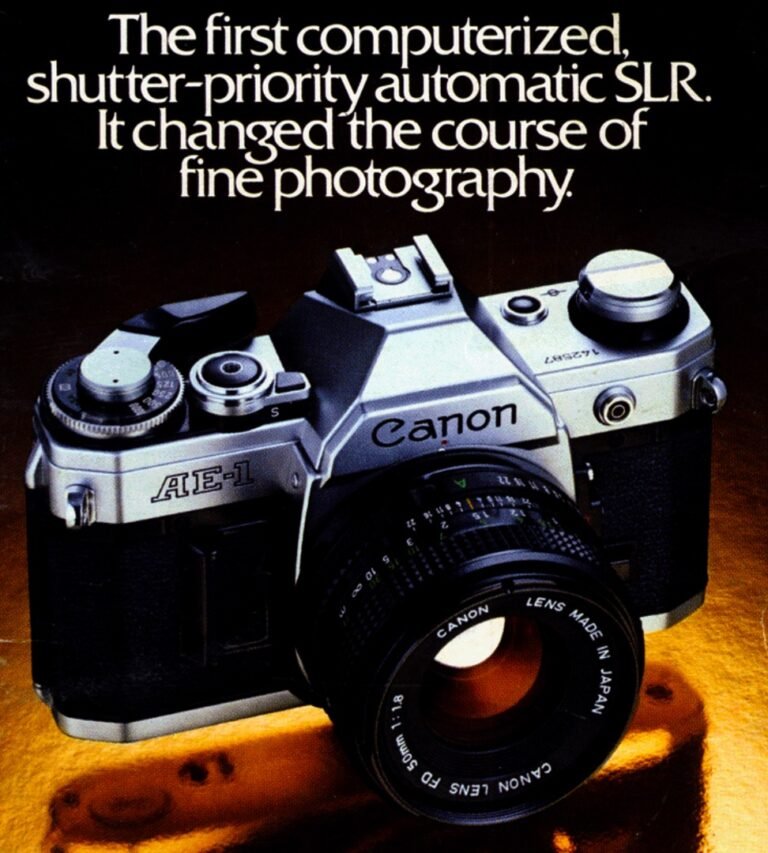I didn’t want a Leica.
Genuinely, I didn’t want a Leica. Of any description.
The prices are astronomical, well out of my league at any rate, and I’ll let you in to another secret whilst I’m at it – I’ve never used a rangefinder of any description in my life. Well, perhaps the Watameter distance scale on my Voigtlander Bessa counts as one, but not a rangefinder camera.
As soon as you delve into the world of Leica you quickly realise you’re in mortgage territory. The worlds most expensive camera ever sold was a Leica and so is the second most expensive just for good measure. Got $15 million burning a hole in your pocket? Then you can buy a Leica series 0 at auction. For the rest of us, you can get by with a mere £5,000 without a lens for a new Leica MP.

You can buy cheap Leica’s if you’re prepared to “slum” it with the non “M” models as the excellent, entertaining Graindead channel showed the world some months ago in this video:
But you probably shouldn’t do this as we’ll discover later.
So, what happened? How did a person who has no money, no real or sensible means of paying the Leica premium tax end up buying a Leica M3?
It’s James Bond’s fault.
In this post:
- It started with a holiday reading book…
- The cost / quality argument
- Why not anything else?
- Buying things I cannot afford
- The lens headache
- First Impressions
- Less talk, more pictures
- Problems and Customer Service
- Conclusions and Learning
It started with a holiday reading book…

As so many people do, I tend to pick up a book to read when on holiday. It’s the only time I ever really sit down and dedicate some time to just calmly reading a novel or biography of some description. When I was much younger, I’d read every single one of Ian Fleming’s James Bond books and they are genuinely superb, if not a little “of their time” in terms of attitudes. Incidentally, one of the reasons Casino Royale is such an incredible film is because it follows the book very closely, rather than the detours so many of the earlier films had taken from the original concept that Fleming had laid down. Bond was a gritty, ruthless character in the books. Cold and calculated in nearly every situation, but with an occasional moment of reflection and humanity that he had to shake off:

Sitting on my bookshelf for at least the last 10 years had been a copy of “Goldfinger” and this summer seemed like as good a time as any to give it a revisit and so it was, in a house in Holland, I found myself ploughing through its pages in a day or two.
Then, there it was, James Bond in his hotel suite, pulling his brand new Government issue Leica M3 out of his suitcase.

I know how stupid this sounds and that’s because… it is stupid, but that is exactly how this started.
This happens a lot, I’ll watch a film, read a book, see something on TV and I’ll see a camera and wonder if there’s a story to be told that might be interesting. Usually this ends with a quick search of eBay to inevitably discover that whichever camera I’ve just seen is “collectible” and therefore well out of range.
At the moment I read the passage above, I did just that and placed my book down, picked the phone up and had a quick look before promptly popping my eyes back in their sockets and putting the phone away again. Leica’s of any description, let alone a James Bond M3 were well out of my price bracket.
How much is too much? Well, right now the cheapest M3 on eBay in the UK (and I really wouldn’t recommend buying one on there) is £1200. The outright cheapest is in Germany and costs 900 Euros. Oh, and it’s broken – so add £200-300 for servicing and parts to bring it up to working condition with a reputable repair shop.
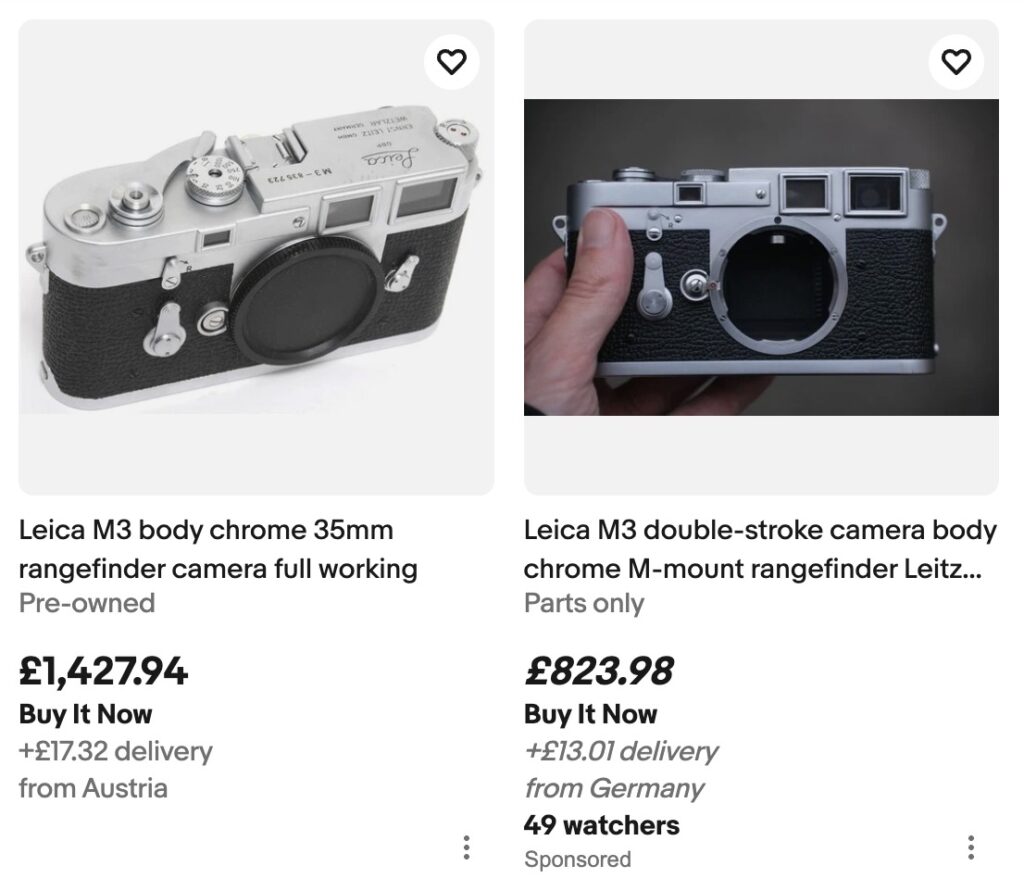
It’s easy to see why I very quickly gave up on the idea, but it turns out that wasn’t enough – the seed had been well and truly sewn. I just hadn’t realised it at that point.
The cost / quality argument
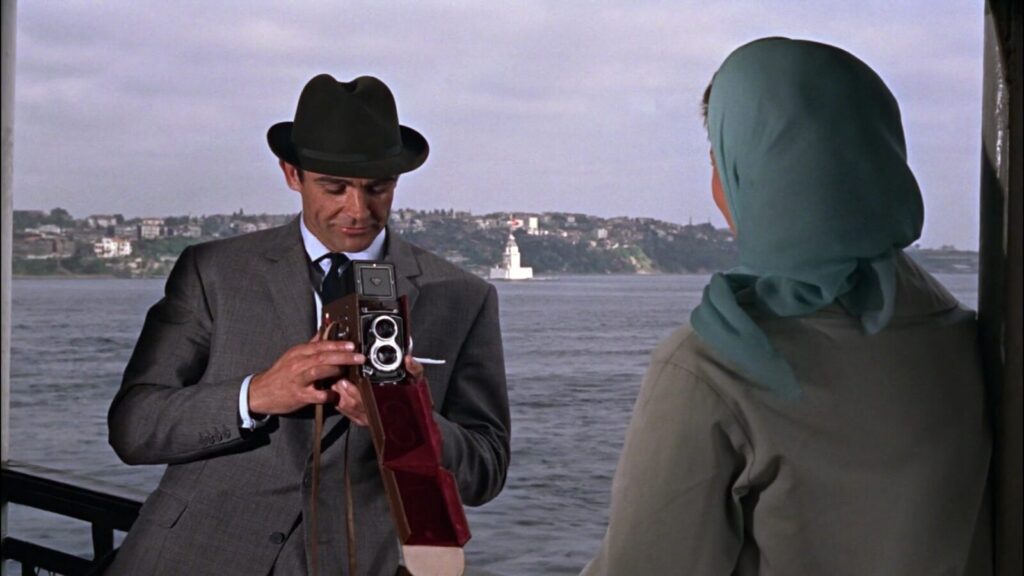
Now, it’s easy to get carried away with the fact that something costs four figures and just dismiss it out of hand, especially if you’re not exactly rolling in cash. However, there is some justification to this Leica premium if you look at it objectively.
Lots of things hold their values for different reasons. Perhaps one of the most bonkers is Apple devices. Apple computers always command a premium over any Intel or AMD, Windows based rival. There are reasons for this – the brand image, build quality and so forth all command a higher price. However, there is one small problem and that is the fact technology has built in, unavoidable obsolescence.
An old Apple desktop or laptop, no matter how much someone once paid for it, will be effectively useless 10-15 years later. There’s no software support for these old machines, Apple have long since stopped issuing updates and security fixes and it’s likely you can’t get a working web browser. I’m aware that there are hacks to get around this and install the latest operating system but there’s no escaping the fact an old machine will crawl along with new software on it. However, people still try to achieve higher than sane prices for their old Apple gear. This doesn’t make sense – no matter how premium it was, it is of little to no use any more.

The inescapable thing about a Leica M series is that this obsolescence doesn’t apply. Until film is no longer manufactured, these cameras will continue to perform in the exact same manner as they did when new. If your Leica breaks, Leica themselves will still repair your camera, still produce spare parts for bodies which were made in the 1950’s and are currently 70 years old or more.
This has to be admired from an environmental point of view if nothing else. Product support like this for other consumer items just doesn’t exist. If you buy a Ferrari F40, do Ferrari still maintain or produce replacement parts for it? I’m not sure, but I bet you’d have to ask very nicely and cross their palm with a nine figure sum. Keeping products going like this is admirable and for roughly £3-400 there’s almost nothing that can’t be repaired. If you think that cost is high, the expertise, time and patience required to service a camera of any description is worth this amount.
A second hand M3 costs roughly £1000 and should, if looked after and serviced by Leica or reputable service shops, last forever. A new Leica MP or M6 is anywhere up to £6000 and if that sounds like a lot, that’s because it is. However, that’s the same amount as a nice e-bike, or an EOS R1. I know that it’s a crazy comparison to put a film camera next to the latest and greatest mirrorless full frame pro spec digital camera, but there’s one key difference – the R1 will die. For all the money you’ve spent, it is just a fact that Canon will abandon it in roughly ten years time, spares will not be available, batteries will die and eventually – some time in the future, no one will be able to use them due to lack of replacement batteries. In 20 years time, your EOS R1 will be worth £200 if it works. In 20 years time, because of their longevity, I dread to think what the price of a Leica would be but it’ll be more than I paid today and I’m glad I got on the bandwagon now.
Why not anything else?

What’s the attraction of the M3 over any of the others?
If you know about Leica’s, and trust me there are people with Leica beards that make Gandalf look clean shaven, then you’ll know that the model numbers don’t make sense. They started with the M3, went down to M2 and M1 then back up to M4, M5 and M6. Makes total sense.
The M3 was the original M series and introduced a new lens mount, range finder assembly and so forth. The M2 and 1 were seen as cost reduced models. Very, very simply, the M2 was an M3 with a manual frame counter and a simplified range finder. The M1 was simpler still and didn’t include a range finder. Roughly 82,000 M2’s were manufactured and not very many M1’s were ever made, coming in at a total of 9431 according to Leica Society International.
Moving quickly on, the M4 was then released as the upgraded M3 with lots of tweaks like easier film loading and people seemed to like the M4 quite a lot. The M5, however, was widely disliked because they turned it into a massive, rectangular lump, deviating from their earlier winning formula. Sales were so bad, Leica restarted production of the M4 and quietly sold them alongside until the release of what many people consider to be the Leica of them all – the M6.
This extraordinarily condensed Leica history leads to some simple conclusions. If you’re going to spend all this money, you might as well discount the M1 and 2. What’s the point of buying a “not quite as good” camera at this price point? No one apparently wants an M5, so that leaves the M3, 4 and 6. The M4 and M6 are at least two times more expensive than a good M3 so that seals the deal in many ways, but there is one more thing.
The M3 is purely mechanical which means that it almost can’t let you down. There’s no light meter to power, no winder, nothing. Properly serviced and maintained, this camera will keep firing no matter what and in terms of longevity and servicing, the lack of electronics mean you can never fall foul of a failed solder joint, a chip that’s given up the will to live or the dreaded corrosion. If you’re buying a camera that’s for life, not just for christmas, then an M3 it is.
Which is fortunate, because I can’t afford any of them, but I definitely cannot afford an M6.
Buying things I cannot afford
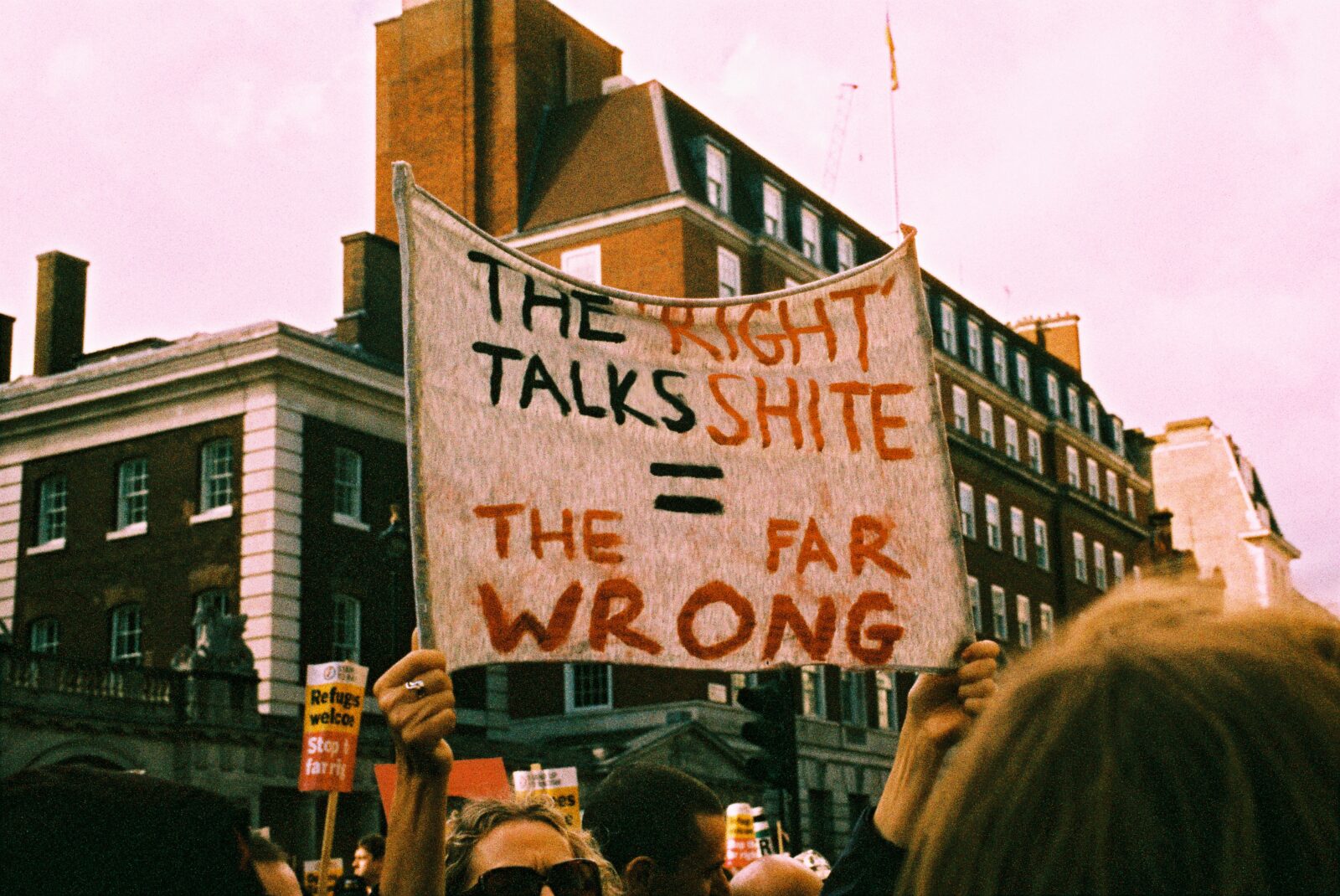
Things started to get serious when I started browsing Ken Rockwell’s incredible archive of reviews and articles. I like Ken because he gives zero shits about pleasing manufacturers, saying the right thing or jumping on bandwagons. He is one of the few people I’ve ever found on the internet that doesn’t have a commercial axe to grind and gives honest, brutally honest opinions that are not swayed by fashions, trends or anything else. Even better still, his website is still pretty much pure HTML that you could knock up in Notepad like it’s 1997 again – when I say he doesn’t believe in the frivolous, I mean it.
Guess what Ken thinks about the M3?
Yep – it is the Leica to own. In fact, let me put it in his own words – “The world’s greatest 35mm camera”
When Ken makes a statement like that, it’s sit up and listen time. Over to Ken for his introduction to this legend of 35mm photography:

What more can I say? Like Ken says, there’s no point reviewing the M3 and this really isn’t a review either – it’s a story of unexpectedly being sucked into the Leica black hole and, trust me, there is no escaping that event horizon when you get too close.
I started looking for M3’s in the usual places – London Camera Exchange, Park Cameras, WEX, Red Dot… The list goes on. One thing I started to realise was that almost nowhere sells Leica’s with a lens. This, sadly, is profiteering at its best but who can blame them, they’re businesses. There was a great M3 with an F2 Summilux at LCE and I almost bought it. Mysteriously, before I could, the listing suddenly changed to body only and the lens magically appeared separately for a large amount of cash.
I’m glad I missed out in the end because one thing all of these stores have in common is a complete lack of servicing – cameras are priced the same regardless, with no indication of any signs of whether they need a look over, whether the previous owner had looked after the camera and so forth. When you’re buying a camera like this, where proper maintenance is absolutely key, I don’t think this is too much to ask.
This is when I came across a company I’d never heard of before that are based in Shrewsbury – The Latent Image. Their store has one key difference – every single Leica they sell has been serviced and repaired as necessary by their in house repair team. They tell you the date, the condition of the camera, parts which have been replaced and then they sell them for… cheaper than everywhere else I could find.
I may not have a lens at this point, but I did have a body that I could trust had been maintained. Not to be bitten twice by the mystery scamming camera company bug, as I had previously with “M W Classic Cameras” of London (do NOT use this company, every review is correct) I Googled the company and could only find positive things being said about them. Better still, they’re close enough that if there were any issues I could just drive over and have a chat. That’s as close to comfortable as you can reasonably get when spending a whack on a second hand camera.

Once I’d found this I convinced myself this was the M3 for me. I then spent the next three days trying to convince myself that this was the most stupid idea I’d ever had. I hovered over the “buy” button, I added it to the basket, I thought twice and left it. Eventually, it drove me round the bend and after talking it through with Mrs Ravioli, I did it.
Now, a lens would probably be sensible.
The lens headache
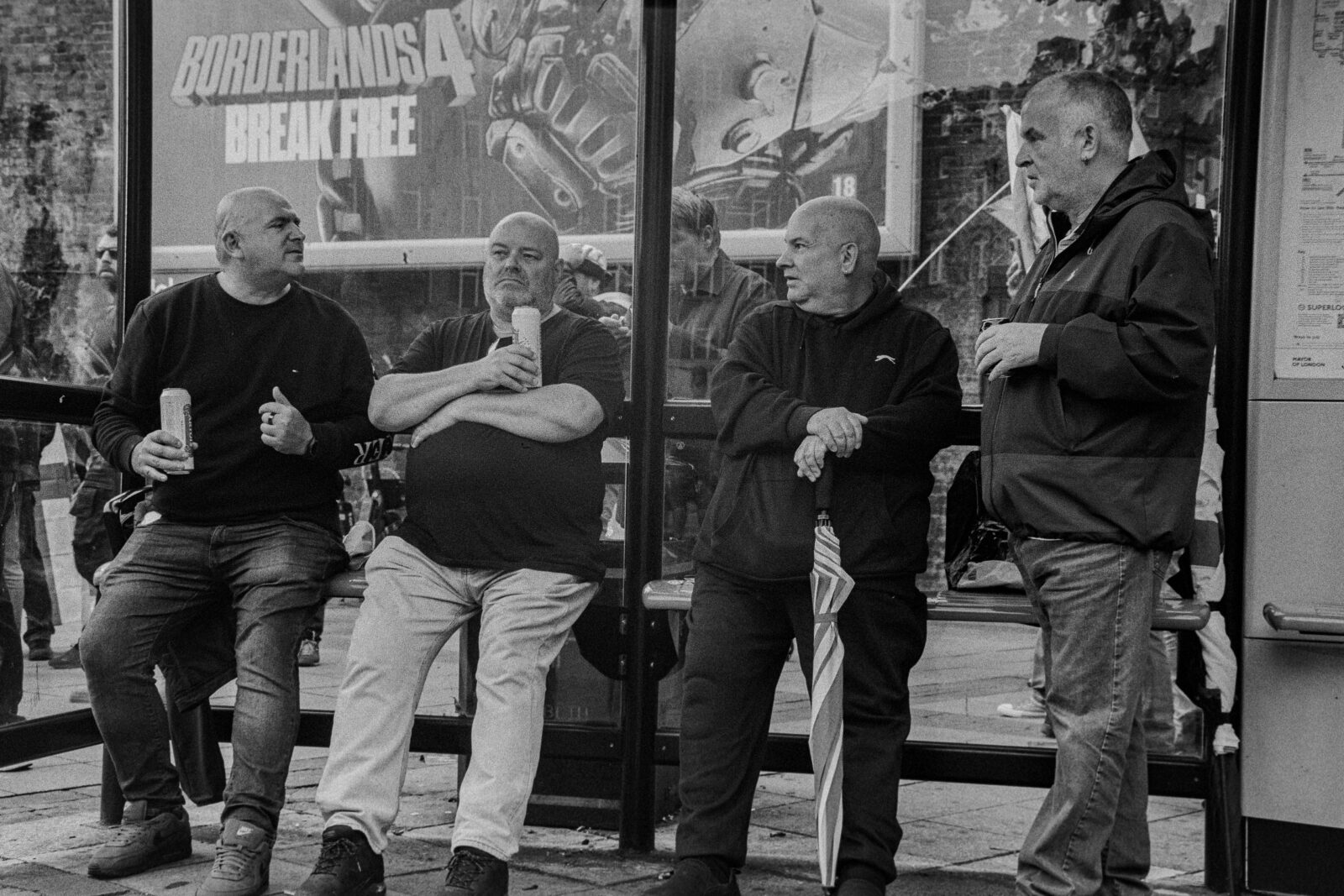
Come on, by now you can predict the contents of the next paragraph, can’t you?
You can’t? Ok. Leica lenses are expensive. The shock!
The M3 was designed for 50mm prime lenses and this was another of the deciding factors of going for the M3 over any other and I am nothing if not an absolute 50mm stalwart. I love primes, I love the 50mm focal length. Zoom lenses give me too much choice and I spend my time messing about deciding which length to use. With a prime, decisions are taken away from you, things are simplified and your only real choice is depth of field. I like this. A lot.
So I needed a 50mm lens, but buying a Leica one at this point in time was just too much. Yes, I’m aware how stupid that sounds when I’ve just blown the house on a camera body. I wasn’t prepared to cheap out and buy an awful old knackered lens for the sake of getting going, there had to be a reasonable middle ground and… it turns out there is.
There’s a company called TTArtisan who are a Chinese manufacturer of various lenses including some reproductions of classic designs from the past. Normally, I’d run a mile from a company that sells their stuff on AliExpress and Amazon but another visit to the Gospel according to Ken and I discovered his utterly glowing review of the 50mm F1.4 ASPH. It happens to be the case that for roughly £300 this is an absolutely banging lens for the money and… £4000 cheaper than the Leica equivalent. It also has that lovely little finger indent focussing ring that I loved the look of every time I saw Kai Wong using one on Youtube.

I decided there’s only so much time you can dedicate to trying to find the bargain to end all bargains, to find the perfect lens and to wade through the absolute quagmire of opinions people have about the quality of various optics, the “you might as well set fire to your camera if you don’t buy the real thing” comments. If it’s good enough for Ken, it’ll do for me. I found one for £300 which is the going price – you can get cheaper but you’re waiting a month for it to come from China and frankly, I wanted it quickly.
This lens is really rated by multiple sources and side by side comparisons with the Summilux equivalent shows almost zero difference and certainly on film, with the resolution I can scan at, you are not going to be able to tell the difference. This seems like a very reasonable compromise.
There is only one small problem with this lens – it needs to have the focus calibrated. As a cost cutting measure, they don’t do this at the factory but do supply you with a focus chart and a little screwdriver to do it. However, unless you have a digital Leica model, you’re buggered. More about this later.
So, for a mere £1250 all in, I was a fully paid up member of the Leica club. Well, the credit card company were, but they let me use it.
First Impressions
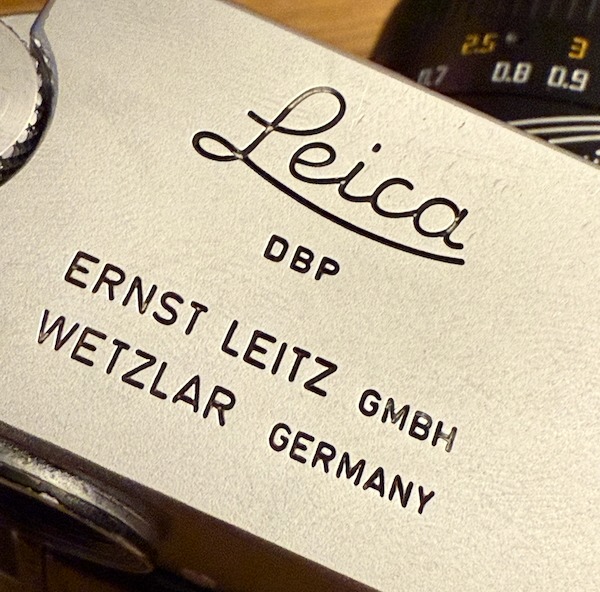
It’s beautiful.
I would say that, though, wouldn’t I? Having spent all the banks money on a camera, it’d be awful if I hated it, but I’m honestly not just saying it.
The first thing I realised is how much smaller it is in real life than in pictures. It’s nowhere near as wide as I expected and feels compact but not cramped. This I like and then… then there’s the viewfinder. I know this is not news to any Leica owner and if this includes you then feel free to skip to the next section, but for anyone who’s not had one before – you really are in for a surprise.
The viewfinder feels massive, is bright and crystal clear and uncluttered. There’s a minimum of blockage by the lens and if I had all the money in the world and fitted it with a Leica 50mm then there’d be none. For a camera that is 70 years old, the condition is nothing short of remarkable.
People often discuss how loading film is fiddly and difficult. It just isn’t. I sat for a while with a test roll and it just drops in place every time. The hardest part is realising that the film take-up spool winds in the opposite direction than you’re used to and it can be a bit of a shove to get the leader to jam into the clip but after a few tries, it becomes second nature.
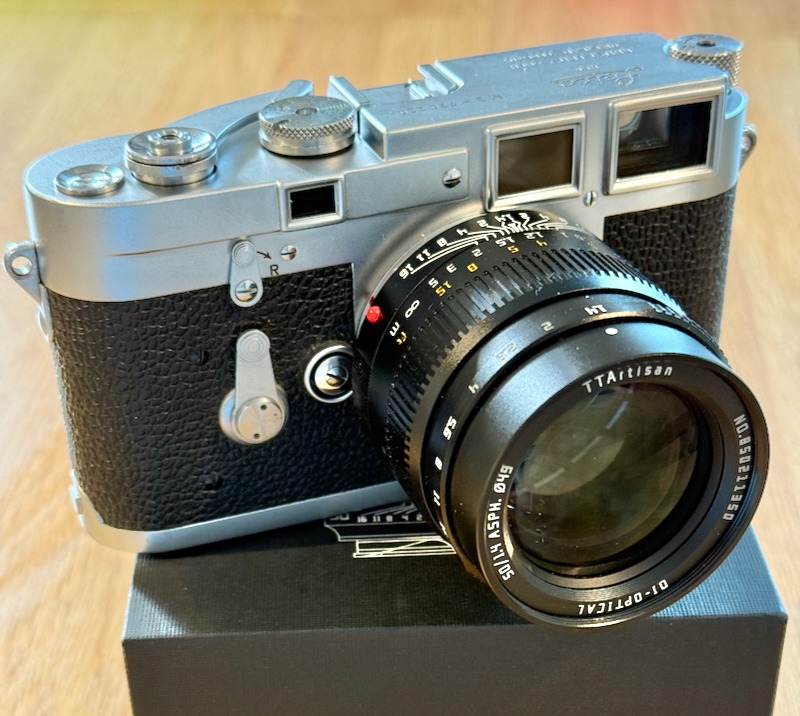
Another common complaint is the rewind knob is apparently too small and takes too long to rewind a film. Compared to a standard crank on an SLR, yes it takes longer but it certainly isn’t difficult nor uncomfortable. My only complaint about the rewind is the force necessary to detach the film leader from the take up spool. Initially, it felt like quite a lot of force was needed to pull the film hard enough to pull the leader out again, it just feels “too much” but this is just new, expensive camera nerves. This feedback is actually very useful as you know that two turns later the film is perfectly retracted with the leader still showing to save you having to retrieve it later for developing. This is a subtle but brilliant design touch.
Maybe I’m just not used to spending money but my biggest problem on day one was to stop my bloody hands from shaking as I held it. That’s not exactly useful for photography and cameras are meant to be tools, not ornaments to be put on a shelf and admired.
Oh and the lens – for what is meant to be a Chinese “knock off” lens, it is extremely well made, tolerances feel perfect and the focus action is smooth with a short throw. I love the focussing tab which feels intuitive and now I just need to develop the muscle memory to remember which way to turn it for infinity and close focus. It feels very well made and reminds me of the many other traditional, manual focus lenses I’ve used before only smaller and lighter. If the pictures look as good as the lens feels, we’re in for a treat.
I finally dropped (literally, you just drop it) in a fresh roll of film, closed the camera up and was ready to go.
Less talk, more pictures
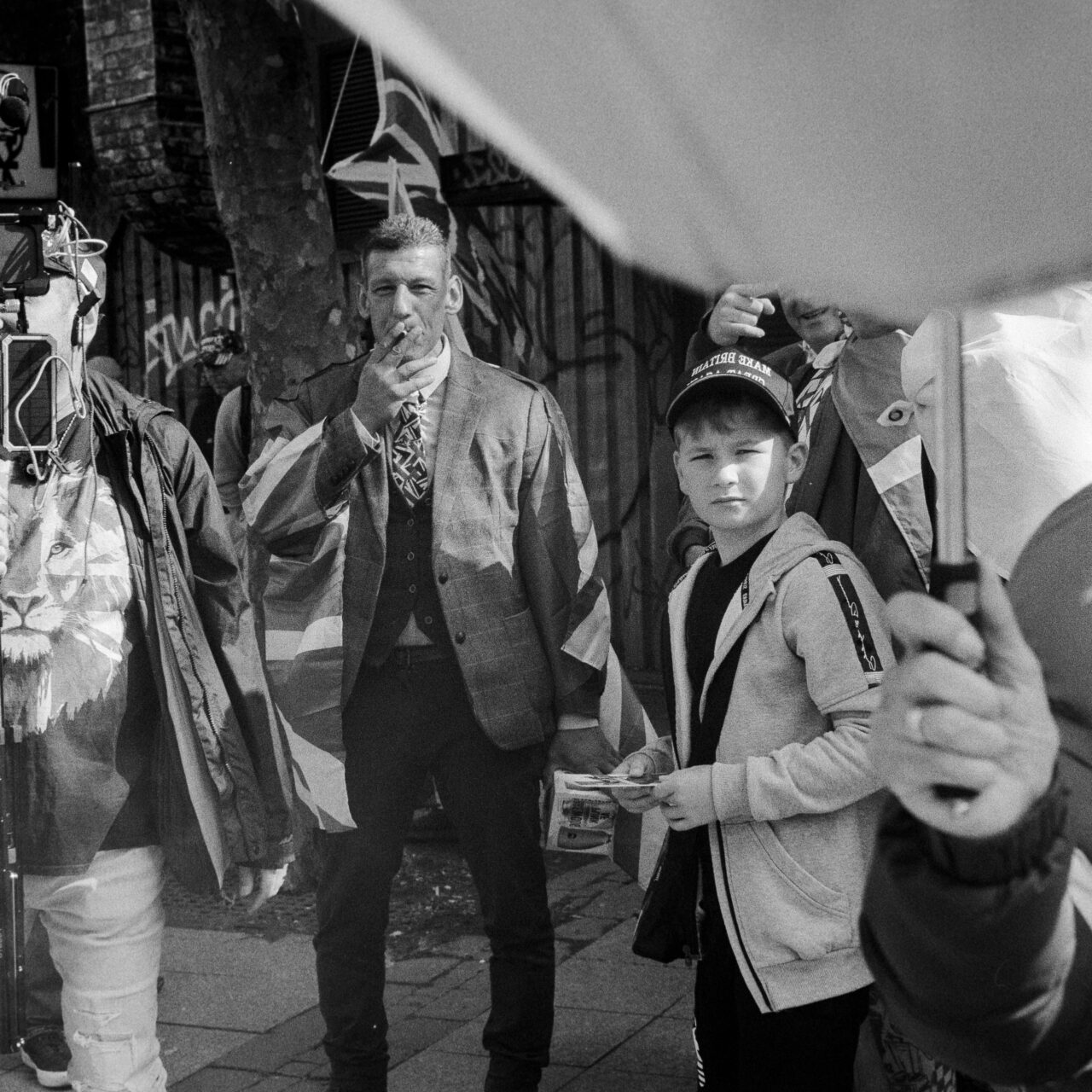
Completely by coincidence I’d been asked by someone to go to London to photograph the recent protests which took place after a certain loud mouth and his racist mates turned up for their regular collective search for a brain cell. Although I took my 5D Mark III with me, my primary concern was using the Leica in anger and putting as many frames through it as I could. The 5D was there for record shots and anything too far for the 50mm to reach.
I loaded up with Foma 200 and filled my bag with several rolls of 100, 400 and a token roll of Harman Phoenix 200 that was sat in the fridge. Now seemed as good a time as any to use it. Jumping in the car at the ungodly hour of 6.30 on a Saturday morning, we nervously drove as near as we dared before using the tube for the final miles into what we thought might turn into some kind of war zone.
I’m fascinated by how people use Leica’s for street photography. I found focussing genuinely difficult at first, the range finder patch in the middle of the viewfinder is quite small and you need quite defined shapes to line up for perfect focus. In a street situation, this is difficult because the lens is smooth but tight and therefore you can’t whip the focus tab around quickly, though the alternative would be a floppy focus ring that slips and that’s no good either.
You then revert very quickly to zone focussing, setting the aperture to F8 or 11 and sticking the lens somewhere in between sensible distances and hoping something comes out. I got better as the day went on but there is still a lot of familiarity to be built up before I feel totally comfortable and I still made mistakes about which way to turn for near and far focus. I did find that once I’d established decent focus on someone, I could quite effectively track them by slowly turning the focus tab and that is probably another sensible way of using the M3 in a street situation.
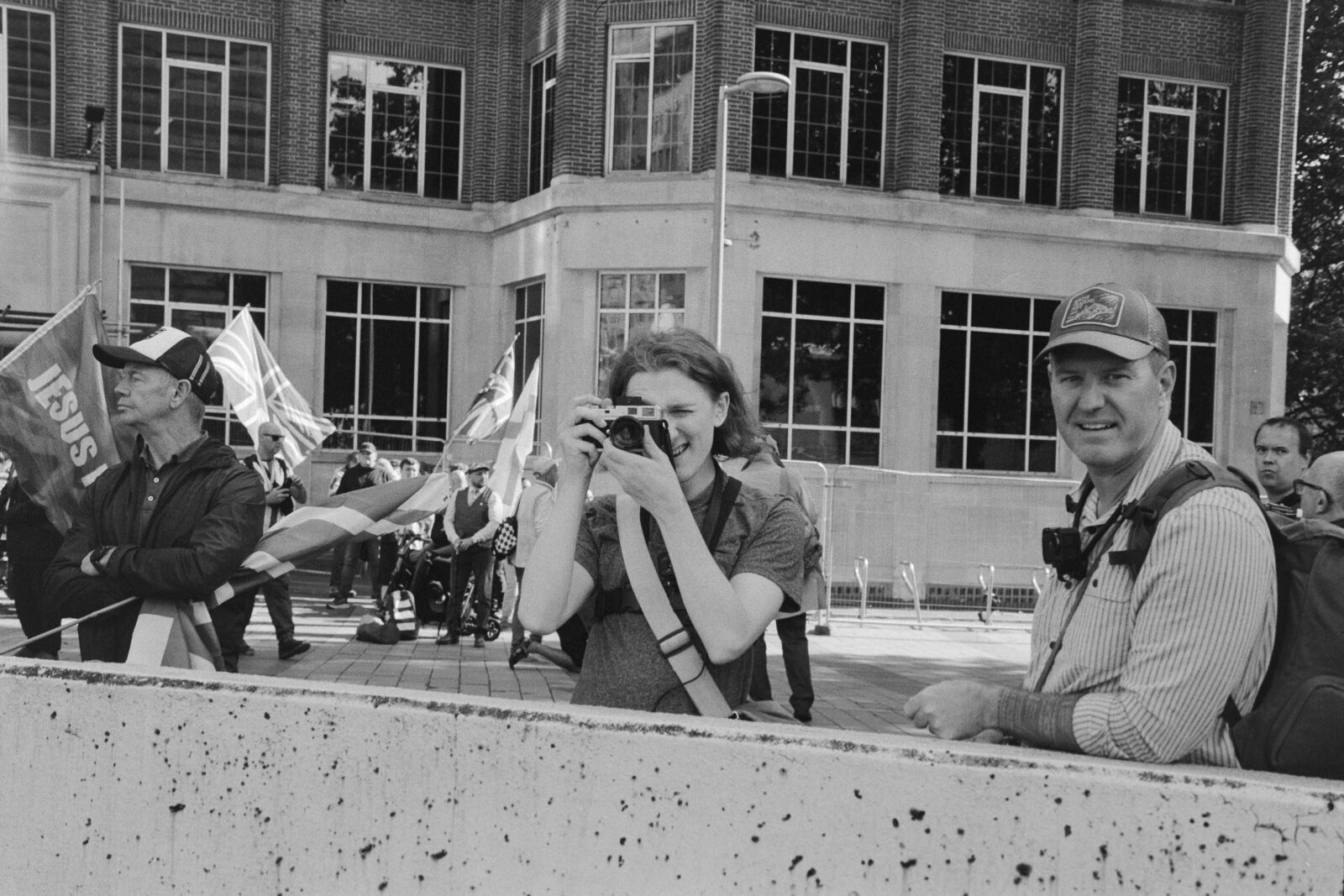
The key here is learning. I didn’t expect to become Leica master overnight and it wouldn’t be fair to judge the camera on one outing alone. The single most terrifying bit of the whole day was when I sat on the tube home, took the used roll of Phoenix out of the camera and thought I’d replaced the bottom properly. Then, in what must be one of the most coincidental strokes of fate I’ve ever known, a woman got off the stop before me and I noticed she very carefully and deliberately checked her seat when she got up to check she hadn’t left anything behind. With this still in my mind, as I got up to get off, I turned, checked where I’d been sitting and to my complete surprise found the bottom of my camera stuffed down the side of the seat. How that happened, I don’t know, but I’m thankful to the careful woman who prompted me to check!
Anyway, after a day of using the M3 and two rolls of film, how was it?
Good. Very good.
Once you get going, the camera is totally intuitive and the clear viewfinder gets out of your way for an immersive experience. The double throw film wind is short, smooth and that too becomes second nature within a few shots. The magnified frame counter is clear and easy to read and the shutter… It’s so nice. The M3 is practically silent to the point I could stand next to someone and they had no idea the shot had been taken.
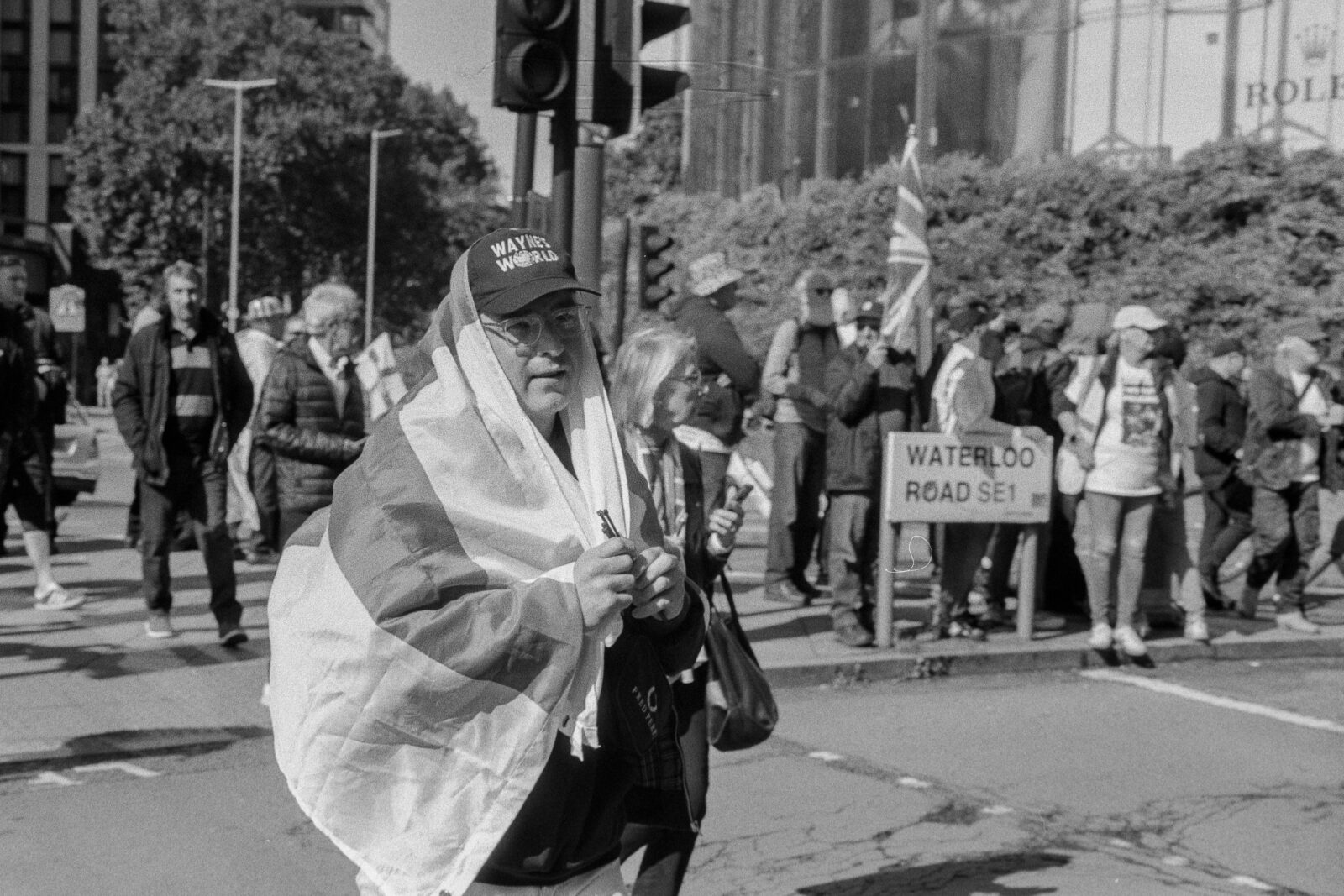
There are difficulties with any fully manual camera. Applying the settings is easy enough, just twist the aperture ring and the same again for the shutter speed. The difficulty comes from having to constantly adjust these settings as the light changes. The conditions were constantly variable due to cloud cover coming and going and I found myself almost constantly bouncing back and forth between F8, F11, 1/250 and 1/500 to balance these changes out. This isn’t a Leica issue, it’s an all manual cameras issue.
The results from the first roll were genuinely surprising. In a roll of 36 exposures, the Leica actually gives 39 usable shots and out of those, only three were out of focus. That’s a pretty good start for a fairly dynamic environment and my first ever time using a rangefinder to focus. The next thing that stands out is how outrageously sharp these images are. All shot between F5.6 and F11, mostly F8, and at a shutter speed range of either 1/250 or 1/500, these negatives are amongst some of the sharpest I’ve ever seen – to the point where I didn’t really apply any post processing sharpening to some of them at all. That was genuinely unexpected.
Problems and Customer Service
My camera is 70 years old and, even though it was sold as serviced, you still can’t expect perfection.
I noticed that every now and again I could see very faint frame lines in the viewfinder that I shouldn’t be able to see with a 50mm lens attached. A tiny twist of the lens barrel made them go away but then after a while it’d undo itself and come back again. This is a minor issue but I’d rather have it perfect if possible.
As previously mentioned, I also discovered that the TT Artisan lens does not come with the focus perfectly calibrated from the factory and you’re meant to do it yourself but I had no idea if the previous owner of my lens had done this or not.
I got in touch with The Latent Image about this and within minutes they’d got back to me and offered to not only check the lens/camera combination but to adjust either the frame line selector or lens mount – whichever was causing the problem and calibrate my lens at the same time. They really didn’t have to do any of this and this is the reason why I really do prefer using “proper” shops for purchases like this now, rather than larger online retailers who exist to just shift volume and couldn’t give a damn afterwards.
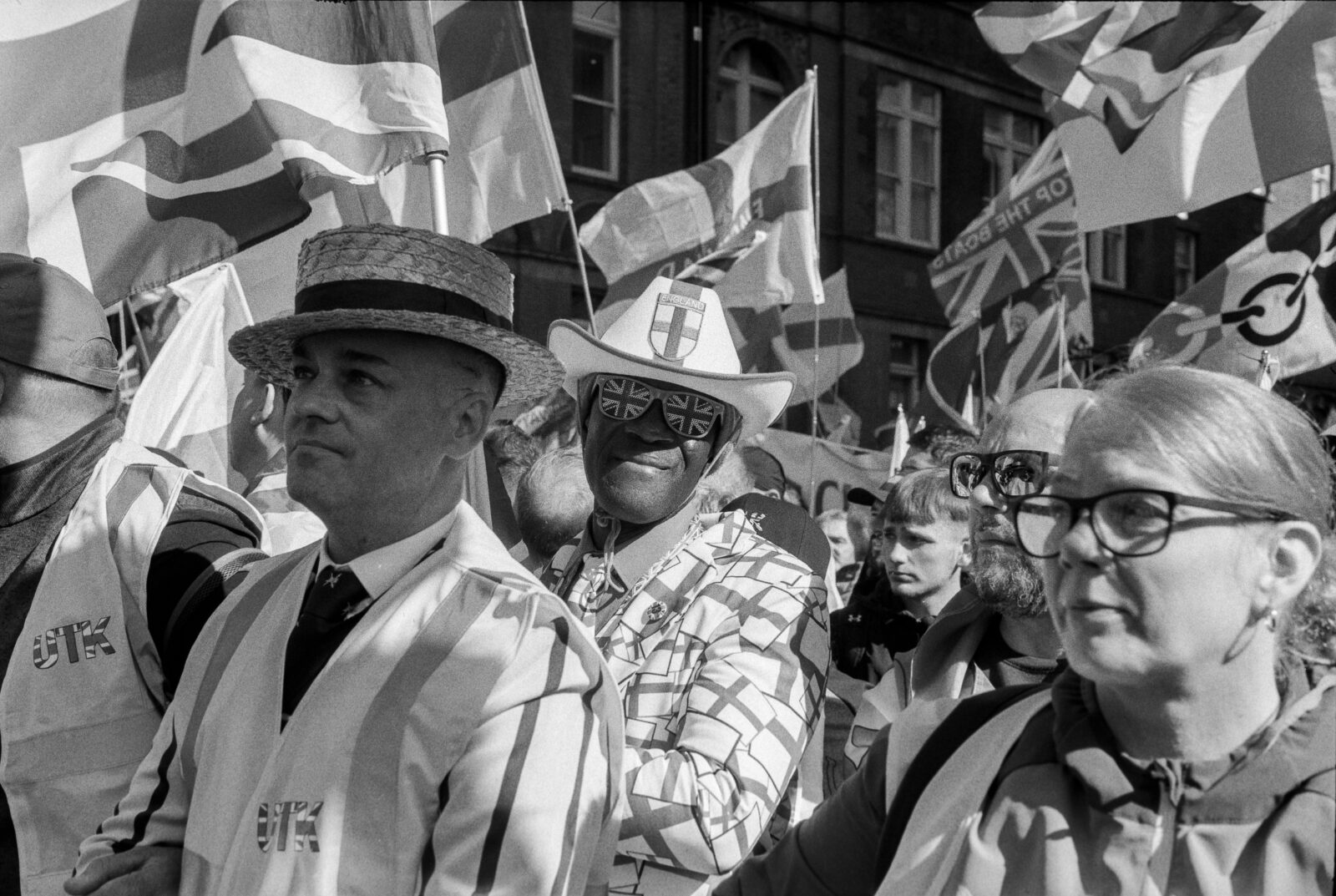
They emailed me a postage label and I packed it all up and sent it off to them for a few days. The owner kept in touch with me throughout and by Saturday (I posted it on Monday) I had the camera back with a properly calibrated lens which was apparently out at infinity, which makes a lot of sense when I look at the roll of Phoenix I shot and some of the infinity shots are definitely well out.
I cannot praise this company enough, they didn’t have to sort my lens out – I didn’t buy it from them and it wasn’t their problem at all but they went the extra mile to put my mind at ease about the frame lines and to offer a service I didn’t pay for. They are out of pocket here and that’s important to remember, this all ate into their profits on this camera yet there wasn’t a hesitation. The bottom line is that customer service like this is rare and when you find it it’s worth shouting about. If I ever pay this thing off, I’ll be straight back for a lens or a Leica iii because now I have real Leica based issues…
Conclusions and Learning

Before we conclude photographically, I think it’s important to do so financially.
Too often you read reviews or watch videos about equipment and whilst price is mentioned, it’s often glossed over. Either that or it’s the casual “oh yeah, I shot this on my Leica MP with a Noctilux F0.9…” like it’s nothing that you’ve blasted £20k on camera equipment, can’t everyone?!
It is really important to acknowledge that for a huge amount of people in society, the sums of money involved in these kinds of purchases is not something to be just casually waved to one side. Statistically, 50% of people are “below average” earners, right? That’s just maths – and in the UK today, that means they earn less than £36,000 a year, which is roughly the average wage here.
On £36,000 a year, if you own a house and a car to get to work with you can safely conclude without knowing the rest of their financial outgoings that they don’t have the money for these kinds of purchases. If you have a family, forget having any spare cash at all. This means that a purchase like this is a genuine, high ticket price luxury that is going to involve some mad saving or borrowing. Some people get very high and mighty about money and spout lots of nonsense in comments sections along the lines of “tighten your belts, then!” and “I paid for my house and all it took was hard work and dedication, people these days don’t know they’re born.” Well, if thats you, good for you. We’re all individual.
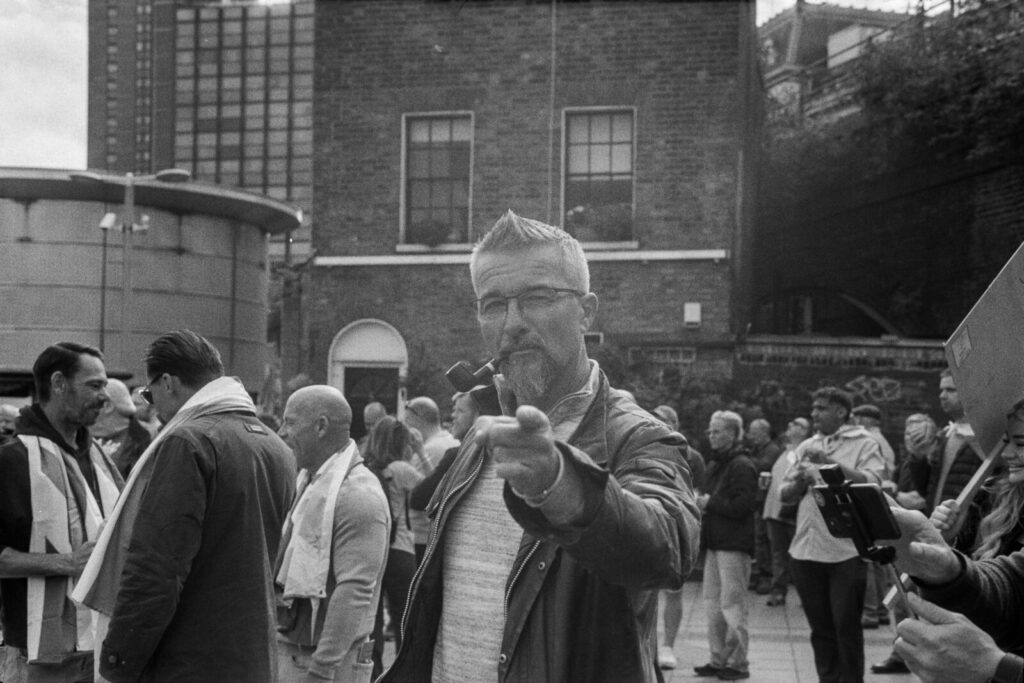
So this is almost embarrassing. I started this site years ago with an absolute focus on budget photography, literally bodging things together out of lamps and old milk bottles. I took pride in trying to find the best bargains, to prove you don’t need to pay thousands of pounds to enjoy yourself – and you really don’t, that holds true still. There’s no escaping, though, that the spending has gradually crept up as time went on.
I bought budget cameras because I couldn’t afford expensive gear. I still, to this day, take a 5D Mark I out with me on assignments as one of my workhorse cameras and I love using it, I never feel like it is in some way letting me down.
And then I bought a Leica.
Other than a house and a car, this is the most I’ve ever spent on anything in one go – and I’m in my 40’s now. I once bought a very nice LG OLED TV that comes close to the price of an M3, but I actually worked a second job and spent my entire savings to buy it without borrowing money on credit cards. That’s the sane thing to do when you want nice things, not to mention the fact that it benefits the whole family and not just me.
Does this mean I’ve sold out? Abandoned my principles? Gone mad?
At least one of those statements is definitely true. I definitely struggled a lot with the idea to buy a Leica. It wasn’t an idea, really, it was an urge. An urge that wouldn’t go away, no matter how stupid that sounds it played on my mind for weeks. I knew it wasn’t sane spending beforehand and I know it isn’t sane spending for someone like me even now.

I think ultimately some of this comes down to your attitude towards spending large chunks of cash. Putting aside those who have debt problems, there are some people couldn’t care less about spending, they don’t let it bother them. They know that they can pay it off eventually, have fun now, worry about it later – do a balance transfer on the credit card when the 0% runs out. Multiple loans and credit cards? Why not?!
I’m not one of those. One card is enough. One loan? I want it paid off. I can handle money, I know how to avoid paying interest and when I see large balances I tend to fixate on paying them down as quickly as possible. It’s just… I’m genuinely terrible at keeping that balance at zero once I’ve paid things off. If you are in my shoes – just a normal bloke working a normal job, living in a normal house, should you go out and buy a Leica on the credit card, if it’s on your bucket list?
Yeah. I think you should. With the caveat of only if you really do financially have your head screwed on and you have a plan to repay it. But this is the advice for any debt you take on.
I have reached a point where, within reason, I think you should probably try your best to enjoy your interests whilst you still have the time, motivation and good health to do so. Waiting for luxury to arrive when you finally quit work is probably an ambition that will fill you with regret. So longs as you’re not putting yourself at stupid levels of risk, just do it.
There’s one more thing to note financially and that’s the fact Leica’s don’t lose their value. If you discover you don’t like it, if for some reason you can’t pay it off, you absolutely have the option to sell it for the same price you paid and walk away from the whole affair. If you get a few years down the line, then your asset will have appreciated. That’s unusual in the second hand world.
So let’s talk photography.
Getting used to a rangefinder, and a manual one at that, isn’t as difficult as you’d think. If I were being picky, I’d love a larger rangefinder patch as there are times when it’s really hard to quickly focus on certain subjects, but in general the M3 is a very easy camera to use. The simplicity of just throwing the focus tab once aperture and shutter speed are set is the main charm, the camera just gets out of the way and lets you enjoy the large, bright viewfinder.
Everything about the Leica is well designed, thought out and feels deliberate. Film loading is genuinely easy and gives you more shots per roll than any other camera I’ve used. There is nothing difficult about preparing the film spool, dropping the film in the camera and doing the initial couple of winds. The rotating red screw inside the rewind knob is a reassuring sign that everything is well once the bottom has been replaced.
The shutter speed dial is perfectly weighted and each setting goes in with a reassuring clunk, whilst the advance lever is perfectly balanced. Having to do two short throws is not as weird as you first think and is no slower than a single, long throw that you might be used to on an SLR. Only once in shooting several rolls of film did I forget the double throw and end up being confused when the shutter did nothing.
Finally, the M3 is discrete or at least it’s discrete to people who know nothing about cameras. I’ve rarely been stopped in the street by someone interested in what camera I’m using but this happened twice in one day when I first went out with it and, of course, one time was by a person who had another M3 – they’re so cheap everyone has one…
In short, everything that has been said and written about the M3 is true. If you want the ultimate manual photography machine, with uncompromising lens quality, ergonomics and feel to die for – this is the camera to buy. I’ve never experienced anything as sturdy and perfectly thought out as this. Everything from the magnified frame counter to the tiny but still robust feeling rewind lever is perfectly proportioned and sturdily made.
But is it, purely as a photographic tool, necessary or essential?
Until this moment, I was a total and utter SLR stalwart. The AE-1 Program or A1 was, and still is in many ways, my ideal camera. I love their lightweight bodies, great lenses, manual focus and obviously through the lens viewfinder which makes focussing and knowing what you’re getting all the easier. But… those cameras have their design weaknesses, their need for a battery in order to work and the lenses have quite long focus throws.
The M3, on the other hand, is almost certainly more rugged, unarguably more robust and better designed and will outlive those SLR cameras without a doubt. Purely by the fact the Leica has no electronics whatsoever, you are already in a better place from a longevity point of view. All chips and capacitors are destined to fail at some point. Furthermore, Leica still support the repair and provision of spare parts and that’s something I admire and desire with a passion. Repairability in todays world with all the consumerism and waste issues we face is a necessity, as far as I’m concerned.
As a pure street photography tool, the M3 is an undeniably excellent choice. Of course you can do this type of photography with almost any camera and your images will still be fantastic, but the smaller nature of a Leica and it’s almost imperceptibly quiet shutter do mean that you can get away with taking images in some situations that you may not do with a mirror slapping SLR in your hands. I understand it now, I couldn’t see this before having one in my hands.
So it’s a done deal – this really is the camera to end all cameras. However, there is just one thing remaining that’s nagging at me – this camera was a want, not a need and in that context, do I really have something which is now a necessity in my photography?
If I’m honest, new gear excites me and more importantly motivates me to go out and take pictures. I’m absolutely not just in it for the possession of endless camera equipment though, telling stories and highlighting issues through photography is really powerful and something that will always inspire me to keep going out, to keep trying to improve my street photography.
This all leads me to an interesting place that I’ve not been in before. Due to this purchase, I genuinely cannot afford to buy any more cameras for a long while. I’ve sold every single camera I had that I don’t cherish or use regularly to help fund the purchase of an M3. I certainly don’t have a hoard any more and I’ll now have to find a different angle to take for a few months, doing projects with the M3 and not a variety of different bodies as I normally would and is necessitated by running a website which requires a conveyor belt of new equipment.
The M3 has certainly justified itself and the price point when compared to other serious photographic tools can almost be seen as “reasonable” but, let’s get to the point, is it necessary? There isn’t an easy answer to that.
Logically, no. No one needs a Leica and you do not need to spend thousands of pounds to take beautiful images.
Emotionally and creatively, yes. I can “see” it now, I can understand why people who pick a Leica up tend to love them and never look back. There is a tangible, visible difference in image quality and the look and feel of each image compared to those taken on an SLR. You wouldn’t notice this if you weren’t looking for it, so it’s the equivalent of pixel peeping on a modern digital camera, but the difference is there.
The real difference comes in the image making process. Without doubt this feels like a tool designed to become the most natural picture taking tool there is. It is the purest of photographic processes I’ve ever known. The viewfinder is huge and if you open both eyes it’s like you’re not holding a camera to one of them. There is no complexity anywhere whatsoever, no options, no extra buttons, no digital information, just you and the world in front of you. You spin the focus tab and click. That’s it. Every time you throw the advance you’re reminded of the quality, the precision of this mechanical masterpiece.
Is the Leica M3 the best film camera ever? What does best mean? It’s not tangible, it means different things to different people. But is it the purest film camera there is? Yeah, it really is. I do not see how it is physically possible to get better than this if you’re truly a passionate film photographer, this is as good as it gets and it was made in 1955.
What a journey.
Share this post:
